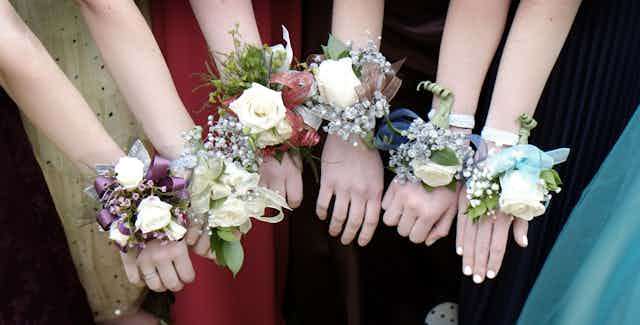That most American of institutions, the high-school prom, has now become a regular feature marking the end of the summer term in many British schools. While “coming-of-age” celebrations are popular in a variety of cultures and countries, the high-school prom transcends the religious observances normally associated with rites of passage.
High-school proms can be expensive – with associated costs of buying an outfit, hiring a limo and adding accessories estimated at between £200 and £1,500 per attendee. While proms are generally for those leaving secondary school in the UK, primary school proms and even proms for those leaving nursery are becoming more common.

High-school proms as we recognise them now originated in the US in the 1950s, although debutante balls in America were the norm in the 18th century. Proms began to occur in the UK around 15 years ago, and have become increasingly popular since.
Research my colleagues and I have worked on has shown that there are many “versions” of the high school prom. Even in the US there isn’t a universal approach to organising one.
American TV programmes and movies often depict a specific type of high school prom that includes girls giving boys matching buttonholes, a prom “theme”, dancing as well as dining and the crowning of a prom king and queen. But the reality can be quite different.
Gaps in wealth inequality mean that for some Americans, prom night is simply a dance in the school hall while for others it is a precursor to a weekend at their parents’ lake house with friends. In some schools, the pre-election campaign of a prom queen who is typically chosen on the night can be akin to that of a US president, with financial and social support key to success.
The British way
Research by my colleague Pete Nuttall at the University of Bath and I conducted showed that high school proms in the UK tend to be a more egalitarian affair. The prom king and queen, if there are any, are typically those who have contributed most to the school experience. This can be linked to charitable acts but can also be intangible, with the accolade often awarded to those recognised as consistently being good humoured or as having a positive effect on others.
If there is to be a prom king or queen at an event this will often be decided by the prom organising committee. The organising committee can include teachers but often is made up of the head boy or head girl as well as students volunteering to be part of the committee. The committee will make decisions about their prom, often reflecting their own style but limiting the budget.
This decision-making can be contentious. Some students attending the prom and sometimes those on the committee want the kind of prom they have seen in American movies, while others want something that reflects their own and national identity. For example, Scottish attendees wear traditional dress such as kilts and engage in Scottish country dancing.
While Scottish proms can feature this traditional dancing they are generally more like a wedding than an American prom. As with a wedding, the key component for girls is the dress. In order to make sure that no two dresses are the same, girls employ strategies to avoid the faux pas, such as posting photos of dresses on social media before the event.
Scottish prom attendees are more concerned with the glamour of the prom than their American counterparts, who are more interested in the heritage and traditions.
Stopping mischief
There can also be a darker side to school proms. In the US, great lengths are taken to prevent “misbehaviour” such as underage drinking. Parents often act as chaperones and sometimes there are lock-downs, where children are kept in school until 6am and engaged in a variety of activities so that their parents can come and collect them, knowing there will be no drink driving. There have been limited reports of these kind of preventative measures so far in the UK.

Of course, not all those who can attend their prom do so. Resistance to prom has led to the creation of a “morp” (prom backwards) in the US – for those who want to mark the occasion less formally. These events typically don’t require a partner and do away with many of the extravagances or rules of the traditional American prom.
But some research has suggested that people who resist the lure of prom night by choice ended up spending more lavishly on their weddings later in life. For example, one interview respondent said he had invited more than 300 people to his wedding because he felt he’d missed out by rejecting prom attendance in his late teens.
Proms can cause angst and conflict between family members – for example, between separated or divorced parents who argue about how much they should reasonably spend on prom night. But the depiction often by the media of proms as excessive, unnecessarily expensive and a disproportionate way to leaving secondary school perhaps misses the point. Research that I’m conducting with colleagues from the universities of Bath and Lancaster indicates that there are benefits to engaging with this ritual of transition at the end of formal schooling. Parents and adolescents who experience financial disadvantage can use it to facilitate social belonging, promote pro-social behaviours and enhance higher educational goals.
For those born in a time before attending high-school prom was an option, take heart. Companies in the US run prom nights for adults looking to recreate the glamour of their prom night with their current husbands or partners. Perhaps youth will no longer just be wasted on the young.

